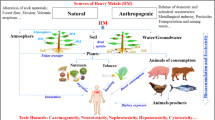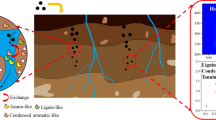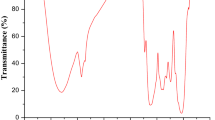Abstract
The green algae Chlorella (Chlorella pyrenoidosa) have the ability to bind high amounts of uranium(VI) in the pH range from 3 to 6. At pH 3 up to 20 % of the uranium is bound by the algal cells whereas the uranium removal by algal cell is almost complete at pH 5 and 6 in the concentration range of 4 × 10−4 to 1.6 × 10−3 M. Sorption capacities are in the range of 300–350 mg g−1 and 250–280 mg g−1 for fresh water and seawater respectively. Concentration of uranium was measured by inductively coupled plasma optical emission spectroscopy (ICP-OES) by using two different emission spectral lines at 409.014 and 424.167 nm. Environmental scanning electron microscopy (ESEM) complimented with energy dispersive X-ray (EDX) is used to characterize the binding sites of uranyl species on algal cell in the selected pH range. The micrographs show a regular distribution of U(VI) on the cell surface. Attenuated total reflectance-fourier transform infrared (ATRFTIR) spectrum of Chlorella indicates that the binding of U(VI) either to phosphodiesters (P–O–aryl/P–O–alkyl), and combination of amine, secondary amine and imine = NH respectively. These sites in Chlorella groups are mainly responsible for the removal and binding of U(VI) by formation of organic and/or inorganic uranyl phosphates.






Similar content being viewed by others
References
Singhal RK, Sharma PK, Bassan MKT, Basu H, Reddy AVR (2011) Comparative determination of uranium in rock phosphates and columbite by ICP-OES, alpha & gamma spectrometry. J Radioanal Nucl Chem 288:149–156
Myers J (1944) The growth of Chlorella pyrenoidosa under various culture conditions. Plant Physiol 19:579–589
Donat R, Esen K, Cetisli H, Aytas S (2009) Adsorption of uranium(VI) onto ulva sp.-sepiolite composite. J Radioanal Nucl Chem 279:253–261
Crist RH, Martin JR, Eslinger JM, Crist DR (1990) Interaction of metals and protons with algae 2. Ion exchange in adsorption and metal displacement by protons. Environ Sci Technol 24:337–342
Horikoshi T, Nakajima A, Sakaguchi T (1979) Uptake of uranium by Chlorella regularis. Agric Biol Chem 43(3):617–623
Khoshmanshi A, Lawson F, Prince FG (1996) Cadmium uptake by unicellular green microalgae. Chem Eng J 62:81–88
Singha lRK, Preetha J, Karpe R, Hema P, Kumar A, Joshi VM, Ranade AK, Hegde AG (2009) Improvement in the determination of traces of uranium in aqueous medium having high dissolved organic carbon and chloride ion by alpha-spectrometry. J Radioanal Nucl Chem 279(1):301–306
Singhal RK, Basu H, Bassan MKT, Manisha V, Avhad DK, Sharma PK, Reddy AVR (2012) Rapid and interference free determination of ultra trace level of uranium in potable water originated from different geochemical environment by ICP-OES. J Radioanal Nucl Chem 292:675–681
Singhal RK, Joshi S, Tirumalesh K, Gurg RP (2004) Reduction of uranium concentration in well water by Chlorella (Chlorella pyrendoidosa) a fresh water algae immobilised in calcium alginate. J Radioanal Nucl Chem 261(1):73–78
Gin KYH, Tang YZ, Aziz MA (2002) Derivation and application of a new model for heavy metal biosorption by algae. Water Res 36(5):1313–1323
Al-Rub FAA, El-Naas MH, Ashour I, Al-Marzouqi M (2006) Biosorption of copper on Chlorella vulgaris from single, binary and ternary metal aqueous solutions. Process Biochem 41(2):457–464
Yong P, Macaskie LE (1988) Bioaccumulation of lanthanum, uranium and thorium, and use of a model system to develop a method for the biologically-mediated removal of plutonium from solution. J Chem Technol Biotechnol 71:15
Donat R, Cılgi GK, Aytas S, Cetisli H (2009) Thermodynamics parameters and sorption of U(VI) on ACSD. J Radioanal Nucl Chem 279:271–280
Wolery TJ (1992) Report UCRLMA-110662 part 1. Lawrence Livermore National Laboratory, California
Meinrath G (1997) Uranium(VI) speciation by spectroscopy. J Radioanal Nucl Chem 224:119–126
Meinrath G (1996) Coordination of uranyl(VI) carbonate species in aqueous solutions. J Radioanal Nucl Chem 211:349–362
Fraile A, Penche S, Gonzalez F, Blazquez ML, Munoz JA, Ballester A (2005) Biosorption of copper, zinc, cadmium and nickel by Chlorella vulgaris. Chem Ecol 21(1):61–75
Becker EW (1994) In: Baddiley (ed) Microalgae: biotechnology and microbiology. Cambridge University Press, Cambridge, New York, pp 186–187
Author information
Authors and Affiliations
Corresponding author
Rights and permissions
About this article
Cite this article
Singhal, R.K., Basu, H., Pimple, M.V. et al. Spectroscopic determination of U(VI) species sorbed by the Chlorella (Chlorella pyrenoidosa) fresh water algae. J Radioanal Nucl Chem 298, 587–592 (2013). https://doi.org/10.1007/s10967-013-2455-5
Received:
Published:
Issue Date:
DOI: https://doi.org/10.1007/s10967-013-2455-5




